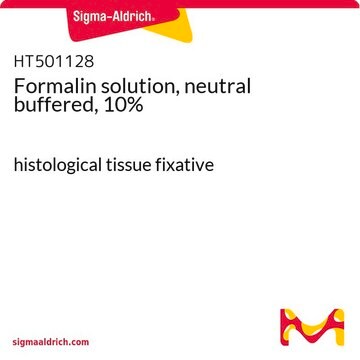If this product has an expiration or retest date, it will be shown on the Certificate of Analysis (COA, CofA). If there is no retest or expiration date listed on the product's COA, we do not have suitable stability data to determine a shelf life. For these products, the only date on the COA will be the release date; a retest, expiration, or use-by-date will not be displayed.
For all products, we recommend handling per defined conditions as printed in our product literature and website product descriptions. We recommend that products should be routinely inspected by customers to ensure they perform as expected.
For products without retest or expiration dates, our standard warranty of 1 year from the date of shipment is applicable.
For more information, please refer to the Product Dating Information document: https://www.sigmaaldrich.com/deepweb/assets/sigmaaldrich/marketing/global/documents/449/386/product-dating-information-mk.pdf
P6148
Paraformaldehyde
reagent grade, crystalline
Sinonimo/i:
Polyoxymethylene
Scegli un formato
Scegli un formato
About This Item
Prodotti consigliati
Grado
reagent grade
Livello qualitativo
Densità del vapore
1.03 (vs air)
Tensione di vapore
<1.45 mmHg ( 25 °C)
Stato
crystalline
Temp. autoaccensione
572 °F
Limite di esplosione
73 %
Punto di fusione
120-170 °C (lit.)
Densità
0.88 g/mL at 25 °C (lit.)
Temperatura di conservazione
2-8°C
Stringa SMILE
[O-]#[C+H2]
InChI
1S/CH2O/c1-2/h1H2
WSFSSNUMVMOOMR-UHFFFAOYSA-N
Cerchi prodotti simili? Visita Guida al confronto tra prodotti
Descrizione generale
Applicazioni
Prodotti correlati
Avvertenze
Danger
Indicazioni di pericolo
Classi di pericolo
Acute Tox. 4 Inhalation - Acute Tox. 4 Oral - Carc. 1B - Eye Dam. 1 - Flam. Sol. 2 - Muta. 2 - Skin Irrit. 2 - Skin Sens. 1 - STOT SE 3
Organi bersaglio
Respiratory system
Codice della classe di stoccaggio
4.1B - Flammable solid hazardous materials
Classe di pericolosità dell'acqua (WGK)
WGK 2
Punto d’infiammabilità (°F)
Not applicable
Punto d’infiammabilità (°C)
Not applicable
Dispositivi di protezione individuale
Eyeshields, Faceshields, Gloves, type P3 (EN 143) respirator cartridges
Elenchi normativi
Forniamo informazioni su eventuali restrizioni prevalentemente per i prodotti chimici. Per altre tipologie di prodotto siamo in grado di fornire soltanto informazioni limitate. Nessuna segnalazione significa che nessuno dei componenti è citato in un elenco. È dovere dell’utilizzatore assicurarsi che il prodotto venga impiegato in maniera sicura e a norme di legge.
EU REACH Annex XVII (Restriction List)
Scegli una delle versioni più recenti:
Possiedi già questo prodotto?
I documenti relativi ai prodotti acquistati recentemente sono disponibili nell’Archivio dei documenti.
I clienti hanno visto anche
Articoli
Available Fluorescent in situ hybridization (FISH) procedures, reagents and equipment.
Protocolli
Cell staining can be divided into four steps: cell preparation, fixation, application of antibody, and evaluation.
Contenuto correlato
Three-dimensional (3D) printing of biological tissue is rapidly becoming an integral part of tissue engineering.
-
How can I determine the shelf life / expiration / retest date of this product?
1 risposta-
Utile?
-
-
How is shipping temperature determined? And how is it related to the product storage temperature?
1 risposta-
Products may be shipped at a different temperature than the recommended long-term storage temperature. If the product quality is sensitive to short-term exposure to conditions other than the recommended long-term storage, it will be shipped on wet or dry-ice. If the product quality is NOT affected by short-term exposure to conditions other than the recommended long-term storage, it will be shipped at ambient temperature. As shipping routes are configured for minimum transit times, shipping at ambient temperature helps control shipping costs for our customers. For more information, please refer to the Storage and Transport Conditions document: https://www.sigmaaldrich.com/deepweb/assets/sigmaaldrich/marketing/global/documents/316/622/storage-transport-conditions-mk.pdf
Utile?
-
-
What is the difference between formaldehyde and paraformaldehyde?
1 risposta-
Paraformaldehyde is the polymeric form of formaldehyde. It is a solid. Formaldehyde is a gas which when dissolved in water gives a formaldehyde solution. Commercially available formaldehyde solutions usually contain 10-15% methanol, which prevents the formaldehyde from forming the polymeric paraformaldehyde.
Utile?
-
-
How to prepare solutions of Product P6148, Paraformaldehyde?
1 risposta-
Paraformaldehyde does not dissolve but rather can be depolymerized in solution. Depolymerized solutions can be prepared in water with heating to 55-60°C. If necessary, further addition of 1-2 drops of a sodium hydroxide solution may be required. Some protocols suggest that paraformaldehyde should be prepared in buffered solutions such as phosphate buffer or PBS at approximately pH 7.
Utile?
-
-
What is the Department of Transportation shipping information for this product?
1 risposta-
Transportation information can be found in Section 14 of the product's (M)SDS.To access the shipping information for this material, use the link on the product detail page for the product.
Utile?
-
-
How stable are Product P6148, Paraformaldehyde, solutions?
1 risposta-
Buffered solutions of 2-4% can be stored protected from light for 2-3 weeks at 2-8°C.
Utile?
-
-
What is the shelf life of Product P6148, Paraformaldehyde?
1 risposta-
The shelf life has not been assigned but guarantee of quality is 1 year from the time of receipt for unopened bottles stored at 2-8 °C. We expect the product to be of good quality for at least 2 years.
Utile?
-
-
What is the difference between formaldehyde and paraformaldehyde?
1 risposta-
Paraformaldehyde is the polymeric form of formaldehyde. Paraformaldehyde is a solid, and formaldehyde is a gas. Formaldehyde solutions consist of formaldehyde gas dissolved in a solvent of some kind.
Utile?
-
Filtri attivi
Il team dei nostri ricercatori vanta grande esperienza in tutte le aree della ricerca quali Life Science, scienza dei materiali, sintesi chimica, cromatografia, discipline analitiche, ecc..
Contatta l'Assistenza Tecnica.











